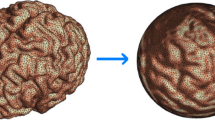Abstract
In this article, we shall show that the metrics defined by Feng and Mao, and Du are equivalent. We also provide some examples for one of the metrics.
Similar content being viewed by others
1 Introduction and preliminary
Let E be a topological vector space (t.v.s.) with zero vector θ. A nonempty subset K of E is called a convex cone if K + K ⊆ K and λK ⊆ K for each λ ≥ 0. A convex cone K is said to be pointed if K ∩ - K = {θ}. For a given cone K ⊆ E, we can define a partial ordering ≼ with respect to K by
x < y will stand for x ≼ y and x ≠ y while x ≺≺ y stands for y − x ∈ K°, where K° denotes the interior of K. In the following, we shall always assume that Y is a locally convex Hausdorff t.v.s. with zero vector θ, K is a proper, closed, and convex pointed cone in Y with K° ≠ ∅, e ∈ K° and ≼ a partial ordering with respect to K. The nonlinear scalarization function is defined by
for all y ∈ Y.
We will use P instead of K when E is a real Banach spaces.
Lemma 1.1 [1] For each r ∈ R and y ∈ Y, the following statements are satisfied:
(i) ξ e (y) ≤ r ⇔ y ∈ re − K.
(ii) ξ e (y) > r ⇔ y ∉ re − K.
(iii) ξ e (y) ≥ r ⇔ y ∉ re − K°.
(iv) ξ e (y) < r ⇔ y ∈ re − K°.
(v) ξ e (.) is positively homogeneous and continuous on Y .
(vi) y1 ∈ y2 + K ⇒ ξ e (y2) ≤ ξ e (y1)
(vii) ξ e (y1 + y2) ≤ ξ e (y1) + ξ e (y2) for all y1, y2 ∈ Y.
Definition 1.2 [1] Let X be a nonempty set. A vector-valued function d : X × X → Y is said to be a TVS-cone metric, if the following conditions hold:
(C1) θ ≼ d(x, y) for all x, y ∈ X and d(x, y) = θ iff x = y
(C2) d(x, y) = d(y, x) for all x, y ∈ X
(C3)d(x, y) ≼ (x, z) + d(z, y) for all x, y, z ∈ X.
The pair (X, d) is then called a TVS-cone metric space.
Huang and Zhang [2] discuss the case in which Y is a real Banach space and call a vector-valued function d : X × X → Y a cone metric if d satisfies (C1)-(C3). Clearly, a cone metric space, in the sense of Huang and Zhang, is a special case of a TVS-cone metric space.
In the following, some conclusions are listed.
Lemma 1.3 [3] Let (X, D) be a cone metric space. Then
is a metric on X.
Theorem 1.4 [3] The metric space (X, d) is complete if and only if the cone metric space (X, D) is complete .
Theorem 1.5 [1] Let (X, D) be a TVS-cone metric space. Then d2 : X × X → [0, ∞) defined by d2(x, y) = ξ e (D(x, y)) is a metric.
2 Main results
We first show that the metrics introduced the Lemma 1.3 and the Theorem 1.5 are equivalent. Then, we provide some examples involving the metric defined in Lemma 1.3.
Theorem 2.1 For every cone metric D : X × X → E there exists a metric which is equivalent to D on X.
Proof. Define d(x, y) = inf {||u||: D(x, y) ≼ u}. By the Lemma 1.3 d is a metric. We shall now show that each sequence {x n } ⊆ X which converges to a point x ∈ X in the (X, d) metric also converges to x in the (X, D) metric, and conversely. We have
Put v n := u nn then and D(x n , x) ≼ v n . Now if x n → x in (X, d) then d(x n , x) → 0 and so v n → 0 too, therefore for all c ≻≻ 0 there exists such that v n ≺≺ c for all n ≥ N. This implies that D(x n , x) ≺≺ c for all n ≥ N. Namely x n → x in (X, D).
Conversely, for every real ε > 0, choose c ∈ E with c ≻≻ 0 and ||c|| < ε. Then there exists such that D(x n , x) ≺≺ c for all n ≥ N. This means that for all ε > 0 there exists such that d(x n , x) ≤ ||c|| < ε for all n ≥ N. Therefore d(x n , x) → 0 as n → ∞ so x n → x in (X, d).
□
Theorem 2.2 If d1(x, y) = inf {||u||: D(x, y) ≼ u} and d2(x, y) = ξ e (D(x, y)) where D is a cone metric on X. Then d1 is equivalent with d2.
Proof. Let then so by Theorem 2.1 in so
and or εe − D(x n , x) ∈ K° for all n ≥ N. So D(x n , x) ∈ e - K° for n ≥ N. Now by [[1], Lemma 1.1 (iv)] ξ e (D(x n , x)) < ε for all n ≥ N. Namely d2(x n , x) < ε for all n ≥ N therefore or .
Conversely, hence so , therefore
So D(x n , x) ∈ εe−K° for n ≥ N by [[1], Lemma 1.1 (iv)]. Hence, D(x n , x) = εe−k for some k ∈ K°, so D(x n , x) ≺≺ εe for n ≥ N this implies that and again by Theorem 2.1 . □
In the following examples, we use the metric of Lemma 1.3.
Example 2.3 Let with ||a|| = 1 and for every define
Then D is a cone metric on and its equivalent metric d is
which is a discrete metric.
Example 2.4 Let a, b ≥ 0 and consider the cone metric with
where d1, d2 are metrics on  . Then its equivalent metric is
. Then its equivalent metric is
In particular if d1(x, y):= |x − y| and d2(x, y):= α|x − y|, where α ≥ 0 then D is the same famous cone metric which has been introduced in [[2], Example 1] and its equivalent metric is
Example 2.5 For q > 0, b > 1, E = lq, P = {{x n } n ≥1 : x n ≥ 0, for all n} and (X, ρ) a metric space, define D : X × X → E which is the same cone metric as [[4], Example 1.3] by
Then its equivalent metric on × is
References
Du WS: A note on cone metric fixed point theory and its equivalence. Nonlinear Anal 2010, 72: 2259–2261. 10.1016/j.na.2009.10.026
Huang LG, Zhang X: Cone metric spaces and fixed point theorems of contractive mapping. J Math Anal Appl 2007, 322(2):1468–1476.
Feng Y, Mao W: Equivalence of cone metric spaces and metric spaces. Fixed Point Theory 2010, 11(2):259–264.
Haghi RH, Rezapour Sh: Fixed points of multifunctions on regular cone metric spaces. Expositiones Mathematicae 2010, 28(1):71–77. 10.1016/j.exmath.2009.04.001
Acknowledgements
This research was supported by the Zanjan Branch, Islamic Azad University, Zanjan, Iran. Mehdi Asadi would like to acknowledge this support. The first and third authors would like proudly to dedicate this paper to Professor Billy E. Rhoades in recognition of his the valuable works in mathematics. The authors would also like to thank Professor S. Mansour Vaezpour for his helpful advise which led them to present this article. They also express their deep gratitude to the referee for his/her valuable comments and suggestions.
Author information
Authors and Affiliations
Corresponding author
Additional information
Competing interests
The authors declare that they have no competing interests.
Authors' contributions
All authors have read and approved the final manuscript.
Rights and permissions
Open Access This article is distributed under the terms of the Creative Commons Attribution 2.0 International License (https://creativecommons.org/licenses/by/2.0), which permits unrestricted use, distribution, and reproduction in any medium, provided the original work is properly cited.
About this article
Cite this article
Asadi, M., Rhoades, B.E. & Soleimani, H. Some notes on the paper "The equivalence of cone metric spaces and metric spaces". Fixed Point Theory Appl 2012, 87 (2012). https://doi.org/10.1186/1687-1812-2012-87
Received:
Accepted:
Published:
DOI: https://doi.org/10.1186/1687-1812-2012-87



